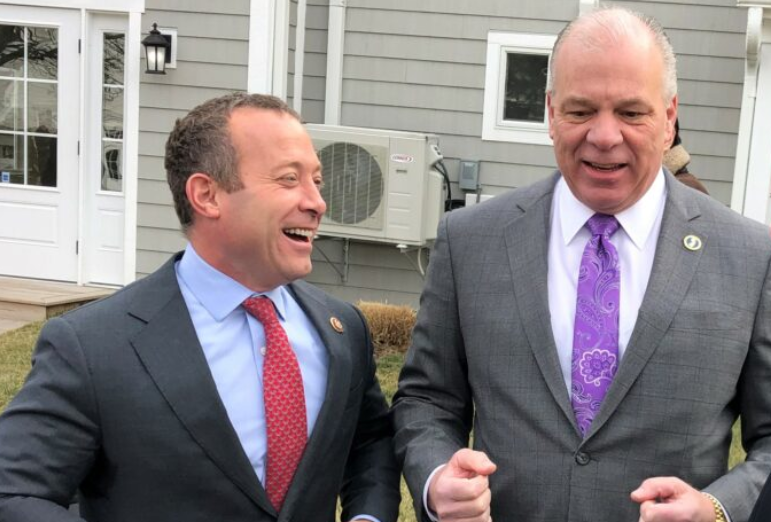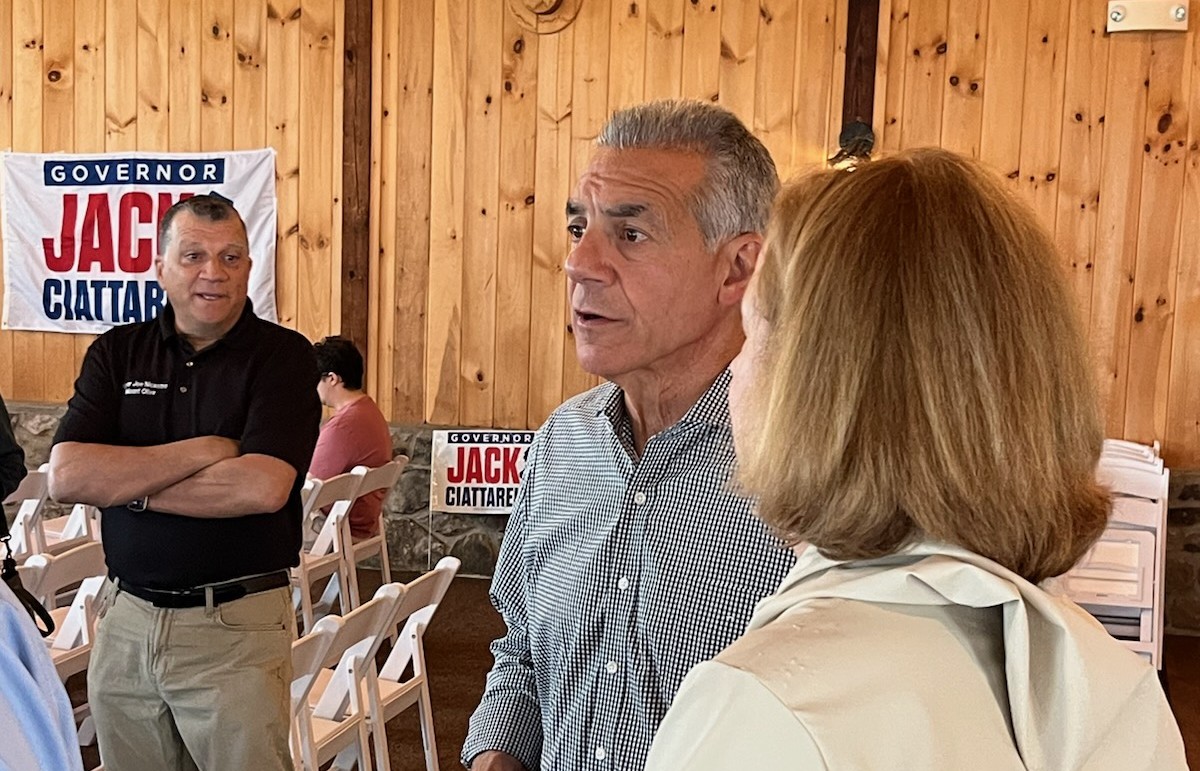
When former senate president Steve Sweeney launched his first gubernatorial campaign ad for the 2025 race Wednesday, he came out with a tough-on-crime, blue-collar style message: this Democrat would support law enforcement and protect New Jersey families. It was a clear, simple, if broad message from the southern New Jersey ironworker. He was flanked by Gloucester County Sheriff Carmel Morina who said of Sweeney, “he doesn’t just talk, he gets [bleep] done… he’s cracked down on illegal guns…”
In northern New Jersey, Congressman Josh Gottheimer is running his own campaign ads as he seeks to succeed Phil Murphy. His message style was “very Jersey” – he appeared to be in a diner at a counter, talking about affordability and his mission to cut taxes. His ad also notes that New Jerseyans always hear about politicians wanting to cut taxes, but invites would-be voters to go to his website and see his tax plan. In another short video, he gets directly to the point and says he will cut taxes. “No bull$h!t.”
New Jerseyans on both sides of the aisle, which seems to have an ever-deepening chasm growing between them, may at least agree that they’d want a governor who can “get $h!t done” and don’t want any “bull$h!t.” It’s the language of the people, and Democrats have often been framed by the opposition as being out-of-touch with average folks, hung up on what they perceive to be more abstract issues rather than bread and butter. In short, bull$h!t.
When a convicted felon comes along, and speaks the people’s language about (sometimes bizarre) issues, but nevertheless ones that hold people’s attention, he is rewarded with the highest office in the land. Dems ignore this at their peril. These two Democratic ads do not compare to the national rhetoric being thrown around, as New Jersey politicians still generally adhere to a degree of decorum. But both of these men, one white collar, one blue collar, one northern, one southern, one a national official, one a former state official, are positioning themselves as “no bull$h!t” issues candidates: tackle crime, tackle affordability. Whether red, blue, green, or independent, everyone except those of the wealthiest class can agree that it is challenging to live in New Jersey and that one’s dollar doesn’t go as far as it did. Safe streets invite a stronger economy and better schools, an overall boost that appeals to anyone.
Both ads represent a race for the middle, to show they are safe and serious candidates that can win in November. Sweeney can categorize himself effectively as the working man’s Democrat, and try to win back some of the blue collar workers who defected to the populism of the Trump camp, feeling Democrats did not represent them. (He himself was deposed by a non-union trucker, Sen. Ed Durr, in a spectacular coup, although the seat flipped back to blue.) Further, as senate president, Sweeney can capitalize on his senior, state level experience for the governor’s bid. Gottheimer has a powerful bastion of support in terms of population and (lots of) money, largely in his Bergen base. For years he has championed himself as a bipartisan leader, working across the aisle for practical solutions and being re-elected in a relatively red district. The question for Democratic voters, then, looking for a centrist choice in a crowded field in the upcoming primary, is who is talking a line of bull$h!t and who is not?
(Visited 57 times, 63 visits today)
In 2025, the political landscape in New Jersey was rocked by a heated air war between two prominent figures: Congressman Tom Sweeney and Congressman Josh Gottheimer. The battle between these two politicians played out in the media and on the airwaves, with both sides launching aggressive campaigns to sway public opinion and gain the upper hand in the upcoming election.
The air war between Sweeney and Gottheimer was characterized by a barrage of attack ads, slickly produced commercials, and carefully crafted messaging designed to paint each candidate in the best possible light while tearing down their opponent. Both candidates spent millions of dollars on advertising, saturating the airwaves with their respective messages and trying to win over undecided voters.
One of the key tactics employed by both Sweeney and Gottheimer was the use of negative advertising. Attack ads were launched by both sides, accusing the other candidate of being out of touch with the needs of the people, being beholden to special interests, and lacking the experience or qualifications to effectively represent their constituents. These ads were often harsh and personal, designed to elicit an emotional response from viewers and sway their opinion against the opposing candidate.
In addition to attack ads, both candidates also focused on promoting their own accomplishments and strengths. Sweeney touted his record on issues such as healthcare, education, and infrastructure, highlighting his efforts to improve the lives of his constituents and make a positive impact in Congress. Gottheimer, on the other hand, emphasized his bipartisan approach to governance, his ability to work across party lines to get things done, and his commitment to fighting for the middle class.
The air war between Sweeney and Gottheimer was closely watched by political analysts and pundits, who saw it as a microcosm of the larger political divide in America. The battle between these two candidates highlighted the deep divisions within the Democratic Party, with Sweeney representing the more progressive wing of the party and Gottheimer appealing to more moderate voters.
Ultimately, the air war between Sweeney and Gottheimer ended in a narrow victory for Gottheimer, who was able to successfully fend off Sweeney’s attacks and retain his seat in Congress. The outcome of this high-stakes battle had far-reaching implications for the future of New Jersey politics, setting the stage for future clashes between progressive and moderate Democrats in the state.
In conclusion, the 2025 air war between Sweeney and Gottheimer was a fierce and hard-fought battle that captivated audiences and dominated the political discourse in New Jersey. The tactics employed by both candidates were aggressive and divisive, reflecting the larger political climate in America. The outcome of this battle will have lasting consequences for the future of New Jersey politics and serve as a cautionary tale for politicians seeking to navigate the treacherous waters of modern political campaigning.



